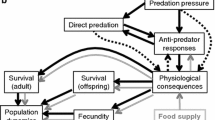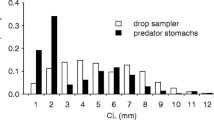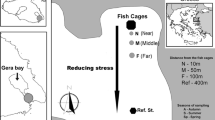Abstract
In order to estimate predation risk in nature, two basic components of predation need to be quantified: prey vulnerability, and density risk. Prey vulnerability can be estimated from clearance rates obtained from enclosure experiments with and without predators. Density risk is a function of predator density, and the spatial and temporal overlap of the predator and prey populations. In the current study we examine the importance of the vertical component of overlap in making accurate estimates of predation risk from the invertebrate predator Mesocyclops edax on rotifer versus crustacean prey. The results indicate that assumptions of uniform predator and prey densities cause a significant underestimation of predation risk for many crustacean prey due to the coincident vertical migration of these prey with the predator. The assumption of uniformity is more reasonable for estimating predation risk for most rotifer prey.
Similar content being viewed by others
References
Allan, J. D., 1976. Life history patterns in zooplankton. Am. Nat. 110: 165–180.
Bowers, J. A. & H. A. Vanderploeg, 1982. In situ predatory behavior of Mysis relicta in Lake Michigan. Hydrobiologia 93: 121–131.
Brandl, Z. & C. H. Fernando, 1978. Prey selection by the cyclopoid copepods Mesocyclops edax and Cyclops vicinus. Verh. int. Ver. Limnol. 20: 2505–2510.
Brandl, Z. & C. H. Fernando, 1979. The impact of predation by the copepod Mesocyclops edax (Forbes) on zooplankton in three lakes in Ontario, Canada. Can. J. Zool. 57: 940–942.
Brooks, J. L. & S. I. Dodson, 1965. Predation, body size, and composition of plankton. Science 150: 28–35.
Confer, J. L., 1971. Intrazooplankton predation by Mesocyclops edax at natural prey densities. Limnol. Oceanogr. 16: 663–666.
Dodson, S. I., 1974. Zooplankton competition and predation: an experimental test of the size-efficiency hypothesis. Ecology 55: 605–613.
Dodson, S. I., 1975. Predation rates of zooplankton in arctic ponds. Limnol. Oceanogr. 20: 426–433.
Drenner, R. W. & S. R. McComas, 1980. The roles of zooplankter escape ability and fish size selectivity in the selective feeding and impact of planktivorous fish. In: W. C. Kerfoot (ed), Evolution and Ecology of Zooplankton Communities. University Press of New England, (NH), Lond.: 587–593.
Drenner, R. W., F. deNoyelles Jr. & D. Kettle, 1982. Selective impact of filter-feeding gizzard shad on zooplankton community structure. Limnol. Oceanogr. 27: 965–968.
Fedorenko, A. Y., 1975. Instar and species-specific diets in two species of Chaoborus. Limnol. Oceanogr. 20: 238–249.
Folt, C. L., J. T. Rybock & C. R. Goldman, 1982. The effect of prey composition and abundance on the predation rate and selectivity of Mysis relicta. Hydrobiologia 93: 133–143.
Gannon, J. E. & S. A. Gannon, 1975. Observations on the narcotization of crustacean zooplankton. Crustaceana 28: 220–224.
Gauld, D. T., 1951. The grazing rate of planktonic copepods. J. mar. biol. Ass. UK 29: 695–706.
Hutchinson, G. E.,1967. A Treatise on Limnology. Volume 2. John Wiley & Sons, Inc., New York. 1115 pp.
Landry, M. R. & R. P. Hassett, 1982. Estimating the grazing impact of marine micro-zooplankton. Mar. Biol. 67: 283–288.
Lehman, J. T., 1980. Release and cycling of nutrients between planktonic algae and herbivores. Limnol. Oceanogr. 25: 620–632.
Li, J. L. & H. W. Li, 1979. Species-specific factors affecting predator-prey interactions of the copepod Acanthocyclops vernalis with its natural prey. Limnol. Oceanogr. 24: 613–626.
Likens, G. E. & J. J. Gilbert, 1970. Notes on quantitative sampling of natural populations of planktonic rotifers. Limnol. Oceanogr. 15: 816–820.
Melville, G. E. & E. J. Maly, 1981. Vertical distributions and zooplankton predation in a small temperate pond. Can. J. Zool. 59: 1720–1725.
Miracle, M. R., 1977. Migration, patchiness and distribution in time and space of planktonic rotifers.Arch. Hydrobiol. Beih. 8: 19–37.
O'Brien, W. J., N. A. Slade & G. L. Vinyard, 1976. Apparent size as the determinant of prey selection by bluegill sunfish (Lepomis macrochirus). Ecology 57: 1304–1310.
O'Brien, W. J., 1979. The predator-prey interaction of planktivorous fish and zooplankton. Am. Sci. 67: 572–581.
Ohman, M. D., 1988. Behavioral responses of zooplankton to predation. Bull. mar. Sci. 43: 530–550.
Pivoda, B., 1977. Migration of planktonic rotifers in Lunzer Obersee (Austria). Arch. Hydrobiol. Beih. 8: 50–52.
Prepas, E., 1978. Sugar-frosted Daphnia: An improved fixative technique for Cladocera. Limnol. Oceanogr. 23: 557–559.
Roche, K. F., 1987. Post-encounter vulnerability of some rotifer prey types to predation by the copepod Acanthocyclops robustus. Hydrobiologia 147: 229–233.
Sokal, R. R. & F. J. Rohlf, 1981. Biometry 2nd Edition. W. H. Freeman and Co. San Francisco, CA. 859 pp.
Threlkeld, S. T. & J. M. Dirnberger, 1986. Benthic distributions of planktonic copepods, especially Mesocyclops edax. Syllogeus 58: 481–486.
Williamson, C. E., 1983. Invertebrate predation on planktonic rotifers. Hydrobiologia 104: 385–396.
Williamson, C. E., 1984. Laboratory and field experiments on the feeding ecology of the cyclopoid copepod, Mesocyclops edax. Freshwat. Biol. 14: 575–585.
Williamson, C. E., 1986. The swimming and feeding behavior of Mesocyclops. Hydrobiologia 134: 11–19.
Williamson, C. E., 1987. Predator-prey interactions between omnivorous diaptomid copepods and rotifers: The role of prey morphology and behavior. Limnol. Oceanogr. 32: 167–177.
Williamson, C. E. & R. E. Magnien, 1982. Diel vertical migration in Mesocyclops edax: Implications for predation rate estimates. J. Plankton Res. 4: 329–339.
Williamson, C. E., M. E. Stoeckel & L. J. Schoeneck, 1989. Predation risk and the structure of freshwater zooplankton communities. Oecologia. 79: 76–82.
Woodmansee, R. A. & B. J. Grantham, 1961. Diel vertical migrations of two zooplankters (Mesocyclops and Chaoborus) in a Mississippi lake. Ecology 42: 619–628.
Author information
Authors and Affiliations
Rights and permissions
About this article
Cite this article
Williamson, C.E., Stoeckel, M.E. Estimating predation risk in zooplankton communities: the importance of vertical overlap. Hydrobiologia 198, 125–131 (1990). https://doi.org/10.1007/BF00048629
Issue Date:
DOI: https://doi.org/10.1007/BF00048629




